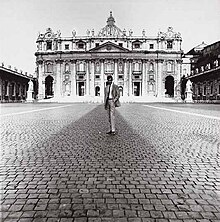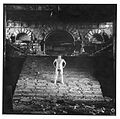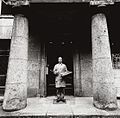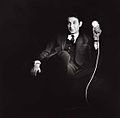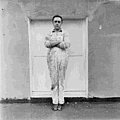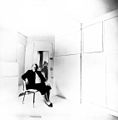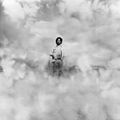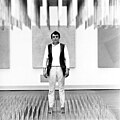Lothar Wolleh
Lothar Wolleh (born January 20, 1930 in Berlin , † September 28, 1979 in London ) was a German photographer .
Lothar Wolleh worked as a commercial photographer until the late 1960s, when he began to portray internationally known painters , sculptors and action artists . A total of 109 artists were photographed, including well-known personalities such as Georg Baselitz , Joseph Beuys , Lucio Fontana , Dieter Roth , Jean Tinguely , Man Ray , René Magritte , Günther Uecker , Gerhard Richter and Christo .
Life
Lothar Wolleh was born in Berlin-Wedding as the first of four sons to the single worker Else Martha Wolleh . He spent the war years in Berlin. The Allied bombing raids, in particular the death of his uncle's family and his participation “in the last contingent” in the final battle for Berlin in April and May 1945, left deep psychological traces throughout his life.
Despite great financial difficulties, Wolleh studied from 1946 to 1947 in the class for elementary education and representational painting with Ernst Rudolf Vogenauer at the University of Applied Arts in Berlin-Weißensee .
From December 1947 to October 1949 he lived in "Boys Town" in Bad Vilbel , a camp for uprooted young Germans maintained by the US Army and based on the approach of Father Edward Flanagan . A few months after his return to Berlin, he was arrested by the Soviet occupying forces in July 1950 and sentenced to 15 years in a labor camp by a special court "OSO" (remote judgment from Moscow) for alleged espionage and diversion under Articles 58.6 and 58.9 of the RSFSR's Criminal Code . Until 1956, Wolleh was in the Vorkuta labor camp in the USSR , where he was doing forced labor in a coal mine. In 1956, Wolleh was able to return to Berlin due to Konrad Adenauer's successful negotiations on the return of German prisoners of war . The torture after the arrest, as well as the harsh detention and working conditions in the coal mining industry, resulted in physical damage and post-traumatic disorders. At the same time, Vorkuta established his first contact with photography and a mythical worship of light.
After his release, he completed an apprenticeship at the Lette-Verein , a vocational school for photography, graphics and fashion in Berlin, from 1956 to 1957 . A World Council of Churches 'several months' recovery program for war-damaged youth, which enabled him to stay on the Swedish island of Gotland in 1958 , established a lifelong affection for the people and the landscape of this region. From 1959 to 1961, Wolleh studied at the Folkwang School of Design in Essen . The photographer Otto Steinert was one of his teachers .
From 1962 until his death he lived and worked in Düsseldorf as a freelance photographer. At first he was mainly active in advertising and later turned to his artistic work. In 1964 he married his wife Karin. His son Oliver was born in 1965 and his daughter Anouchka in 1966. In 1979 Lothar Wolleh died in London after an asthma attack after portraying Henry Moore . His grave is on Gotland.
plant
As a freelancer for the advertising agency TEAM , to which Helmut Newton also belonged, Wolleh advanced to become one of the most famous and most expensive fashion, advertising and portrait photographers in Germany. His customers included well-known companies such as the Deutsche Bundesbahn , Tchibo and Volkswagen . In 1965 he portrayed Ludwig Erhard for the campaign for the federal election.
From 1962 to 1965, Wolleh photographed the Second Vatican Council in Rome . With the help of Father Emil Schmitz SJ, Wolleh's first photo book was The Council. Second Vatican Council published in 1965 by Belser-Verlag. In 1975 he illustrated the message of Pope Paul VI. on the occasion of the holy year in the color photo film with the title of the papal bull Apostolorum Limina (Belser-Verlag). This work, with its blurring and blurring, represents a radical further development of Wolleh's color photography, as suggested by the first ribbon "Council".
In 1969, Wolleh traveled through the Soviet Union for several months. The photographs taken on this trip found their way into the 1970 illustrated book USSR - The Soviet State and its People , which he published together with Heinrich Böll and Valentin Katajew in Belser Verlag.
At the suggestion of his friend, the German painter and object artist Günther Uecker , from 1967 on, Wolleh began to systematically portray a total of over one hundred internationally known painters, sculptors and action artists. From the 1970s on, Wolleh hardly worked as an advertising photographer and devoted himself almost exclusively to his series of artist portraits, in which he initially photographed the artists he knew from the Düsseldorf scene, including Heinz Mack , Otto Piene , Joseph Beuys and Gerhard Richter . But soon his project expanded beyond the borders of the Rhineland to all of Europe, again focusing on the ZERO Group or the Nouveau Réalisme .
The resulting series of portraits resulted in several extensive photo book projects and collaborations with artists. In 1970/1, the volume “Uecker” was created in the Edition Artifex in an edition of 530. In 1972, Wolleh created the film Black Room-White Room for Günther Uecker's action of the same name. In 1978 the Uecker portfolio "To the sign of writing or speechlessness" was created with photos by Lothar Wolleh, some of which Uecker painted over. The painted photographs are, among other things, the templates for the subsequent edition of the same title in 1979. 1970 photographed Wolleh the action Felt TV by Joseph Beuys , by Gerry Schum was shot on film or video. In 1972 the photo band Art Scene Düsseldorf was created , which was accompanied by multiples of the artists.
Several book and art portfolio projects remained unfinished, such as a volume on Lucio Fontana , Jan Schoonhoven , “Art Scene Düsseldorf No. 2 “with work u. a. to Dieter Roth , Stefan Wewerka , Klaus Rinke , as well as the documentation about the “funeral banquet” of the Nouveau Réalisme group on the occasion of its dissolution in Milan in 1970. The illustrated book “Men of the Economy”, in which company founders and managers of leading German companies were portrayed, could not be published because of feared attacks by the Red Army Faction . Other projects were the underwater book that Beuys and Wolleh had planned together and for which Wolleh created the 51 format-filling images. The pictures were taken when the Beuys exhibition was being set up at the Moderna Museet in Stockholm in 1971.
Several stays in Poland took place between 1977 and 1979 . worked in the Wolleh until his death on the unfinished photo volumes The Black Madonna of Czestochowa and Wawel Castle . During this time numerous portraits of the Polish avant-garde were created.
Lothar Wolleh pursued idiosyncratic design principles in his work, which give his portraits an unmistakable signature. His works are precisely designed and staged through a clear, often strictly symmetrical image structure. The people portrayed are mostly placed as full figures on the vertical central axis in the upper half of the picture. The camera is often on the floor or close to the floor, so that it takes up almost the entire lower half of the picture, has a base function and a clear horizon line divides the picture surface. Another characteristic is black and white photography, in the context of a basically square format. Lothar Wolleh portrayed a total of 109 artists.
Rediscovery
After his untimely death, the work and activities of Lothar Wolleh were initially forgotten. His son Oliver Wolleh took over the development and administration of the photographic estate and initiated numerous exhibitions and publications. The first major solo exhibition took place in the Kunsthalle Bremen in 2005 - the first step in the rediscovery of his work, which continues to this day.
Portrayed artists
Other artists portrayed by Lothar Wolleh include Magdalena Abakanowicz , Max Bill , Pol Bury , Alexander Camaro , Christo , Sonia Delaunay-Terk , Paul Dierkes , François Dufrêne , Robert Filliou , Vic Gentils , Karl Gerstner , Gotthard Graubner , Raymond Hains , Al Hansen , Bernhard Heiliger , Dorothy Iannone , Ferdinand Kriwet , Laszlo Lakner , Adolf Luther , Heinz Mack , Claes Oldenburg , Roman Opalka , César Pelli , Martial Raysse , Hans Richter , Klaus Rinke , Ulrich Rückriem , Reiner Ruthenbeck , Jesús Rafael Soto , Daniel Spoerri , André Thomkins , Mark Tobey , Georges Vantongerloo , Stefan Wewerka , Fritz Wotruba .
Publications
- Lothar Wolleh: The Council. Second Vatican Council. Chr.Belser Verlag, 1965.
- Lothar Wolleh, Heinrich Böll, Valentine Katajew: USSR. The Soviet state and its people. Chr.Belser Verlag, 1970, ISBN 3-7630-1548-5 .
- Lothar Wolleh (Photo), Günther Uecker: Nail book. Verlag Galerie Der Spiegel, Cologne 1971.
- Lothar Wolleh: Art Scene Düsseldorf 1st Chr.Belser Verlag, 1972.
- Lothar Wolleh (Photo) Pope Paul VI .: Apostolorum Limina. Litterae Apostolicae. Arcade Verlag, Brussels 1975, ISBN 2-8005-0100-6 .
- Lothar Wolleh (Photo), Günther Uecker: Ludwig van Beethoven's Leonore. Idea of an opera. Belser Verlag, 1978.
- Lothar Wolleh (Photo), Günther Uecker, Guido de Werd (Text): Stage sculptures for Lohengrin. Municipal Museum Haus Koekkoek, Kleve 1981.
Exhibitions (selection)
- 1962: Otto Steinert and students. Photographic exhibition , group exhibition in the Göppinger Galerie, Frankfurt am Main
- 1964: Color photography. Pictures from the Vatican , solo exhibition: Treasury of the Essen Minster . The exhibition was opened by the Bishop of Essen, Hengsbach (on March 21, 1964)
- 1965: Cycle of color photos for the Roman Council , solo exhibition in the Valentin Gallery, Stuttgart
- posthumously
- 1979: Lothar Wolleh (NIEMCY). Portrety Artystów , solo exhibition at Muzeum Sztuki w Łodzi , Poland
- 1980: Lothar Wolleh: portraits of artists. Art objects, photographs , solo exhibition of artist portraits in the Städtische Kunsthalle Düsseldorf
- 1986: Lothar Wolleh - The photo as a piece of art , solo exhibition of the Lippische Gesellschaft für Kunst e. V. in Detmold Castle
- 1995: Lothar Wolleh 1930–1979: portraits of artists - art objects, photographs , Ahlen Art Museum
- 2005-2007: Lothar Wolleh. A rediscovery: photographs from 1959 to 1979 , Kunsthalle Bremen , Ludwig Museum Koblenz , Kunst-Museum Ahlen, Stadtmuseum Hofheim am Taunus
- 2006: Joseph Beuys in action. Healing powers of art , group exhibition: museum kunst palast , Düsseldorf
- 2008: Photos write art history , group exhibition: museum kunst palast, Düsseldorf
- 2008: Immortal! The artist's photo , State Museums in Berlin , Art Library
- 2008: Lothar Wolleh: artist portraits , gallery f5,6, Munich
- 2009: Lothar Wolleh: Portraits d'artistes , Goethe-Institut Paris
- 2012: Lothar Wolleh: Joseph Beuys in the Moderna Museet, Stockholm, January 1971 , Hamburger Bahnhof - Museum für Gegenwart , Berlin
- 2012: The Council - Photographs by Lothar Wolleh, Berlin , Bonifatiushaus Fulda
- 2013: Lothar Wolleh (1930–1979): The Second Vatican Council in pictures: photographs , Franz Wärme Haus, Münster
- 2014: Lothar Wolleh artist portraits from the sixties and seventies , Kunstmuseum Magdeburg
- 2015: Lothar Wolleh - Die ZERO – Künstler , pavlov's dog , Berlin
- 2015: Lothar Wolleh - Vaticanum II , Galerie f5,6, Munich
- 2017: Lothar Wolleh - Portraits of internationally known artists , Galerie Ruth Leuchter, Düsseldorf
- 2018: Lothar Wolleh - Bernd Jansen artist portraits , Hermann Harry Schmitz Institute - Museum, Düsseldorf
Works in public collections
- Kunsthalle Bremen
- Ahlen Art Museum
- Folkwang Museum , Essen
- Kunstpalast , Düsseldorf
- Tate Gallery of Modern Art , London
- Scottish National Gallery , Edinburgh
- Muzeum Sztuki w Łodzi , Łódź
literature
- Karl-Heinz Hering: Lothar Wolleh. Portraits of artists, art objects, photographs. Art Association for the Rhineland and Westphalia, Düsseldorf 1980.
- The photo as a feat. In: Art magazine. Edition 8/1980.
- Patricia G. Berman, Art Scene Düsseldorf: The Performative Print. In: Reinhold Heller, Anja Chávez: Two and One, Printmaking in Germany 1945–1990, Davis Museum and Cultural Center, Wellesley College. Wellesley, Mass. 2003, ISBN 0-9744898-0-8 .
- Wulf Herzogenrath , Burkhard Leismann (ed.): Lothar Wolleh. A rediscovery. Photographs 1959–1979. Hauschild Verlag, Bremen 2005, ISBN 3-89757-304-0 .
- Kristina Lowis (Ed.): Immortal! The artist's photo. Staatliche Museen zu Berlin, Berlin 2008, ISBN 978-3-88609-656-5 .
- Udo Kittelmann (Ed.): Lothar Wolleh. Joseph Beuys in the Moderna Museet, Stockholm, January 1971. Bookstore Walther König, Cologne 2012, ISBN 978-3-86335-263-9 .
Web links
- Page by Lothar Wolleh Raum, Berlin
- Spiegel: State in Gala: Lothar Wolleh and others: "USSR. The Soviet state and its people
- Lothar Wolleh - A Rediscovery , exhibition in the Ludwig Museum in the Deutschherrenhaus, Koblenz
- Lothar Wolleh - A rediscovery. Photographs 1959–1979 Exhibition in the Hofheim City Museum
- Lothar Wolleh: Joseph Beuys in the Moderna Museet, Stockholm, January 1971 , exhibition in the Hamburger Bahnhof Museum für Gegenwart, Berlin
- Culture MD Lothar Wolleh Exhibition in the Art Museum Magdeburg
- BZ: A great photo treasure is being raised here (April 29, 2015)
- Detailed biography and picture examples of Lothar Wolleh
- Document gallery on Lothar Wolleh's detention in Vorkuta
- Exhibitions, by and with Lothar Wolleh
- Lothar Wolleh Artist Talk Photoweekend Düsseldorf 2017
Individual evidence
- ↑ a b c Wulf Herzogenrath, Burkhard Leismann (ed.): Lothar Wolleh. A rediscovery. Photographs 1959–1979. Hauschild, Bremen 2005, ISBN 3-89757-304-0 , p. 122.
- ^ Ingrid Bachér “For Lothar Wolleh - Draft of a Portrait” in Karl-Heinz Hering: Lothar Wolleh. Portraits of artists, art objects, photographs. Art Association for the Rhineland and Westphalia, Düsseldorf 1980.
- ↑ Oliver Wolleh "Memories of my father" http://www.workuta.de/Lothar_Wolleh/biografisches.html
- ↑ Patricia G. Berman, Art Scene Düsseldorf: The Performative Print, in: Reinhold Heller, Anja Chávez, Two and One, Printmaking in Germany 1945–1990, Davis Museum and Cultural Center, Wellesley College, Wellesley, Mass., 2003.
- ↑ Miriam Halwani: He was a kind of treasure hunter Lothar Wolleh - Lothar Wolleh as a photographer of Joseph Beuys in Stockholm. In: Joseph Beuys at Moderna Museet, Stockholm, January 1971. Bookstore Walther König, 2012, ISBN 978-3-86335-263-9 , p. 10.
| personal data | |
|---|---|
| SURNAME | Wollh, Lothar |
| BRIEF DESCRIPTION | German photographer |
| DATE OF BIRTH | January 20, 1930 |
| PLACE OF BIRTH | Berlin |
| DATE OF DEATH | September 28, 1979 |
| Place of death | London |
